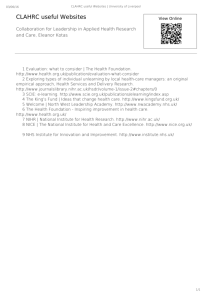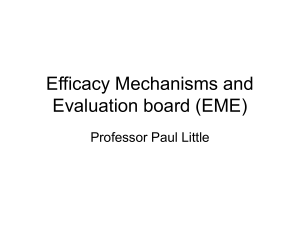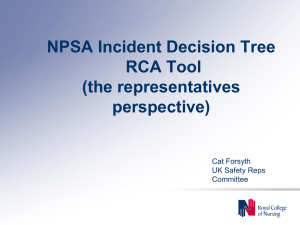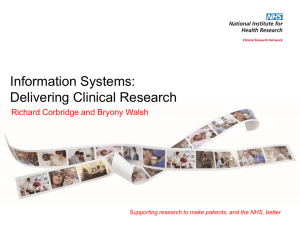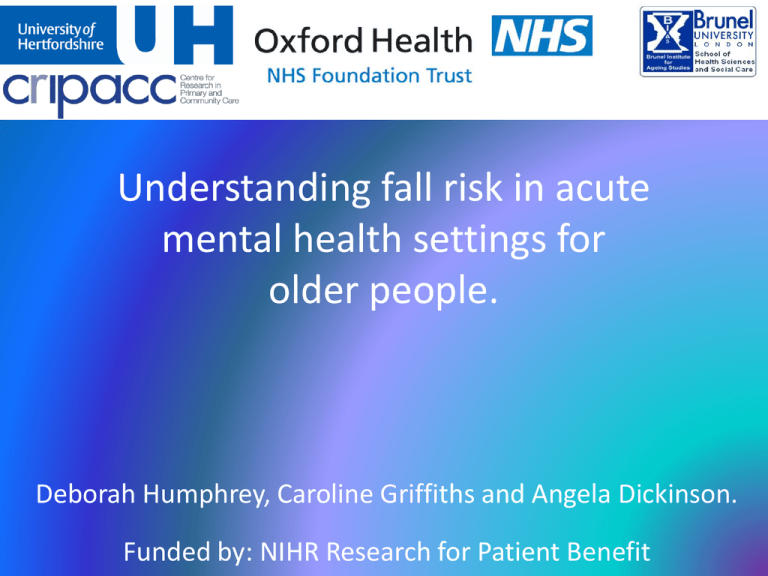
Understanding fall risk in acute
mental health settings for
older people.
Deborah Humphrey, Caroline Griffiths and Angela Dickinson.
Funded by: NIHR Research for Patient Benefit
Research Team
• Angela Dickinson (PI), Senior Research Fellow, University
of Hertfordshire
• Deborah Humphrey, Head of Nursing Older Adult Mental
Heath, Oxford Health NHS Foundation Trust
• Venkat Narayanan, Research Physiotherapist, Oxford
Health NHS Foundation Trust
• Caroline Griffiths, Lead Physiotherapist, Oxford Health
NHS Foundation Trust
• Charles Simpson, Research Fellow, University of
Hertfordshire
• Christina Victor, Professor of Gerontology and Public
Health, Brunel University
Background
• 36,000 falls in mental health units in UK every year
(NPSA 2010).
• Falls and fear of falling lead to anxiety and loss of
confidence for older people.
• Affect rehabilitation, physical and mental function,
increase length of stay in hospital settings and
likelihood of discharge to long term care settings.
• Impaired mental status adds further risk,
particularly if treated with psychotropic
medication.
• Depressive symptoms, control and reduced morale
increase risk of falls in older people with mental
health problems.
Research Aims:
1.
To evaluate how falls prevention and management
are understood and experienced, in inpatient mental
health settings providing care for older people.
2.
To analyse current local and national falls policy and
guidelines specific to mental health settings.
3.
To develop local policy, practice guidelines and
patient and carer information which is fit for
purpose and relevant to mental health settings for
older people, and make recommendations for
national policy.
Research Design: Overview
Phase 1:
Exploratory Case
Study
•
•
•
•
Falls incident report (3 years)
Non-participant observation (over 300 hours)
Focus groups-staff (n=45)
Interviews- managers (n=6)
Phase 2 ‘Patient
Tracking’
•
•
•
•
Incident fall
Interviews with patient and/or carer (n=22/5)
Interviews with ward staff (n=48)
Notes review
Phase 3:
Developments of
guidelines
• Working groups
• Dissemination Conference
Setting
Ward
Type
No
beds
Sex
No falls
reported
2010
No falls No falls
reported reported
2011
2012
Environment:
Purpose built
A
Mixed
17
Female
54
72
62
Yes
B
Organic
17
Mixed
59
69
44
No
C
Mixed
17
Mixed
31
70
61
No
D
Functional 21
Mixed
77
63
62
No
E
Mixed
Male
69
41
86
Yes
17
Who falls, when and where?
• 40% had a primary functional diagnosis, 46% an organic
mental health diagnosis (14% non specific mental health
diagnosis/problems)
• Mean Age of those falling 81.7yrs (Range 59-99)
• Patients fell on average on their 50th day of admission (43 days
for organic diagnosis and 65 days for functional illness).
• Only 27% of falls were directly observed by staff
• There were temporal and spatial patterns to falls.
• Most falls were in bedrooms (42%), day rooms (20%) and
corridors (12%). Peaks in falls occur in morning and early
afternoon.
Limitations of using routinely
collected data
• Most falls are unobserved: ‘found on floor’ (57%)
• Not all falls (slips and trips) reported
• Fall incident reports often lack detail
I would have probably just put it in the progress
notes, ... because you would be doing notes
anyway, so it’s not really any extra work. To fill
out the critical incident forms are very timeconsuming, and staff really haven’t got the time
to do this unless it’s something major.
Need to look at perceptions of staff and patients
Theme 1: Co-morbidity of patients
(physical and mental health)
• Complex mix of mental & physical health
problems
• Challenge to MH trained staff (skills &
training)
• Physical problems can be missed/interpreted
as MH
• Poly-pharmacy (Most of patients taking more
than 4 medicines, max n=12)
Theme 2: Perception of falls
• Physical problem
Perceived to be remit of Doctor/physio
(Can limit use of MH skills in fall prevention)
• ‘Behavioural’ falls
• ‘Accidental’ in nature
• Influence of environment
Theme 3: Prevention and
management of falls
• Focus on limited repertoire of ‘interventions’
• Heavy reliance on surveillance: ‘level 2’ observations and
‘referral to physio’.
• Reducing risk of injury vs prevention of falls
• Medication review, but all patients tracked continued to
be prescribed medications associated with fall risk.
• Some use of equipment- patchy (beds, hip protectors)
• Exercise opportunities could be extended.
• Little evidence of patient educational interventions.
Theme 4: Risk and Falls
• Challenges of balancing risk and
independence at patient level
• Differences in thinking about risk across
organisation, disciplines and within teams
• Much of thinking around risk is ‘hidden’.
• Perception of poor fit of fall policy/assessment
tools with ‘real world’ of practice
Risks: Staff
• ‘no fall is the same’
• But inevitably my patient group are old,
they’re frail, they have lots of physical
comorbid problems, in addition to their
mental health problems which increase the
risk of them falling. It’s a fairly high probability
that people will fall, it’s just about trying to
reduce the damage that happens.
Risks: Manager
• And it’s not about blame it’s about trying to learn,
can we do this better, can we prevent this sort of
thing happening again...
• but I think we are quite aware of risk. I’m not sure
we’re always as good at documenting it as well as it
could be, and I think sometimes risk assessments, a
lot of risk assessment happens but it’s going on in
people’s head and it’s not always clearly
documented.
Conclusions & Implications
• Poor but improving quality of fall reporting.
• Understanding temporal and spatial patterns
could help in planning care.
• Complex co-morbidity and poly-pharmacy
• Does mental health nurse training prepare nurses
to care for the current demographic of older
people?
Disclaimer
This paper presents independent research
commissioned by the National Institute for
Health Research (NIHR) under the Research
for Patient Benefit programme. The views
expressed in this publication are those of the
authors and not necessarily those of the NHS,
the NIHR or the Department of Health.
Where next? education
• Development of the Older People’s Education
and Research Network (OPERN)
• Development and evaluation of an
educational programme focusing on
understanding falls and the changing health
and care needs of older patients.
• Programme will be web-based, using data
from the research as a basis, include podcasts,
lectures, quizzes and film.
Where Next? Research
• Study to understand and explore acceptability
and feasibility of using technologies such as
video and accelerometers to learn more about
‘unseen falls’.
Where Next? Research
• Development of fall prevention interventions
appropriate for the complex group of patients
being cared for in acute mental health settings
(not just patients with dementia).
What next? Your ideas…
• How can OPERN work with us to develop ideas
into education/research and to make a
difference to older people’s care and wellbeing?

